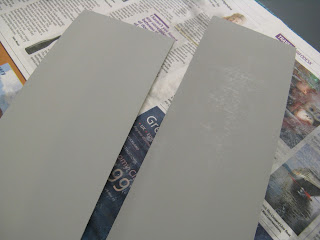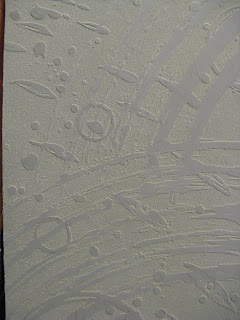Through repeated trials and testing I've managed to fine tune some of my process
since my previous post, so here is an update of some key points:
 |
| Etched lino shows an all-over texture after etching |
Problem: Lino shows an all-over texture after etching - this texture could be used to your advantage but for what I had in mind, I don't always want it.
Solution: sand the lino with wet and dry sandpaper (I used 400 grit). I noticed that some lino I have used etches smoothly while some etches leaving a background texture. I tested 2 pieces of lino - Silkcut and some from National Art Supplies. The NAS lino has a harder, more plasticky surface.
Sand the surface to achieve an all-over even matte surface. This is easy and quick with Silkcut but it takes quite a bit of time and elbow grease with the other lino.
 |
| Sand the lino with wet and dry sandpaper to form a slurry all over the surface. |
 |
| Silkcut lino on the left after sanding, other lino on the right - you can see it still has a bit of a sheen in patches so needs more sanding. |
 |
| Both lino samples are etching evenly and at the same rate. |
 |
| Lino etches smoothly |
 |
| I cut away areas of the lino plates that had etched with the strong texture to see what effects I might achieve. |
 |
| Lino plate - etched and cut by Toni Hartill |
The main thing I am learning from this repetition of trial and error is that I am fine-tuning the process and materials to MY way of working, in fact I am learning WHAT my way of working is. I'm not one to take a set of guidelines or rules and to follow them precisely - I'll reinterpret them my own way - ask anyone who has tried to cook from one of my recipes - they are NEVER as they are first written.
You may find some of the steps don't work for you,
or with your materials - there are so many variables in this printmaking lark that can make all your efforts go pear-shaped: is it the paper weight, the ink, the pressure of the press, the dampness of the paper, the position of venus, the pattern of my tea leaves!??? or is it just me?.....
So, my advice is,
follow instructions only so far,
then, through lots of your own trials
make it work for you and your way of working.
And I'd love to hear and see what works for you
if you'll share your successes in return.
Happy experimenting!



This comment has been removed by a blog administrator.
ReplyDeleteHi Toni,
ReplyDeleteA completely unrelated question to your post, but I found an earlier post of yours showing how you converted a mangle to a print press. I am a papermaker and am currently renovating the same mangle to press paper and just wanted to know what material you used for the roller tubes and what was the outside diameter? Thanks so much for your anticipated help. Peter (Adelaide, South Australia).
Hi Peter,
DeleteThe old, somewhat borer-chewed wooden rollers were sleeved in tubes of mild steel pipe which we just got from a scrap merchant. The pipe was about 5mm thick and the inner diameter needs to be smaller than the diameter of your wooden rollers so that they can be lathed and then the metal tube is pressed on tightly. The outside of the tube is then lathed. We were lucky enough to have a neighbour who was a toolmaker who did this part for us. Good luck! Hope it works out for you too.